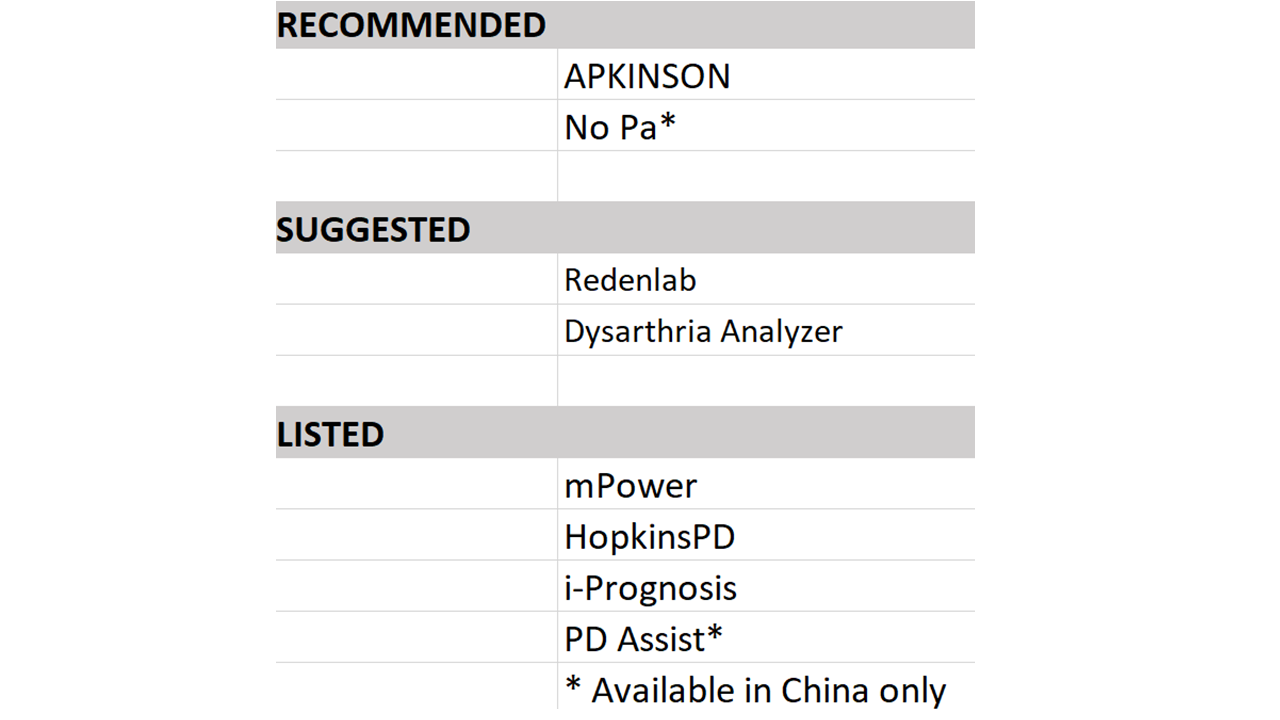Category: Technology
Objective: Our goal was to review the current literature aiming to (i) list, (ii) compare and (iii) classify voice-based technologies that objectively measure the presence and/or severity of Parkinson’s disease (PD) symptoms.
Background: There is growing interest in objective assessment of key components of PD. This includes the voice analysis using smartphone-based devices and other accessible technologies [1], [2]. These devices can provide unbiased measurements that may be useful in clinical practice as well as in scientific research. However, clinical validation and clinimetric properties vary among these different devices.
Method: A search of Pub Med and related online resources was conducted to identify relevant technologies making use of the voice as a biometric for identifying PD or measuring progression and/or disease state. For each device, a search was then conducted for the terms “Parkinson* AND [name of the technology], looking for original articles related to the development and implementation of each device. This was supplemented with a narrative review of apps and other technologies with voice analysis capacity.
The devices were then classified as (i) “recommended”; (ii) “suggested” and (iii) “listed” based upon the following criteria: (1) Previous usage in the assessment of PD; (2) Implementation and further research is feasible by entities external to the developers and research team; and (3) Successful clinimetric testing.
Results: 8 relevant technologies were identified via the combined searches. 4 were identified as “recommended” (“Apkinson”, “mPower2”, “Hopkins PD”, and “No Pa”);2 were identified as “suggested” (“Redenlab” and “Dysarthria Analyzer”); and 2 were identified as “listed” ( “I-prognosis” and “PD Assist”).
Conclusion: Although there has recently been a proliferation of devices, our results identified limited viable options available for use by clinicians, researchers and others. These tools have a range of capacities with different strengths and weaknesses, and their suitability for clinical and research applications is likewise varied. Further progress is needed to develop tools to capture voice data with availability on multiple platforms to allow clinicians, researchers and even people living with PD to improve diagnosis and treatment of PD.
References: 1 Fagherazzi G., Fischer A., Ismael M., Despotovic V. Voice for health: the use of vocal biomarkers from research to clinical practice. Digit. Biomarkers. 2021;5(1):78–88.
2 Zhan A, Mohan S, Tarolli C, Schneider RB, Adams JL, Sharma S, et al. Using Smartphones and Machine Learning to Quantify Parkinson Disease Severity: The Mobile Parkinson Disease Score. JAMA Neurol. 2018 Jul;75((7)):876–80.
To cite this abstract in AMA style:
J. Dean, V. Iankova Md, S. Schneider. Characteristics and validity of technologies analyzing voice features to assess symptoms – a review [abstract]. Mov Disord. 2022; 37 (suppl 2). https://www.mdsabstracts.org/abstract/characteristics-and-validity-of-technologies-analyzing-voice-features-to-assess-symptoms-a-review/. Accessed January 7, 2026.« Back to 2022 International Congress
MDS Abstracts - https://www.mdsabstracts.org/abstract/characteristics-and-validity-of-technologies-analyzing-voice-features-to-assess-symptoms-a-review/

